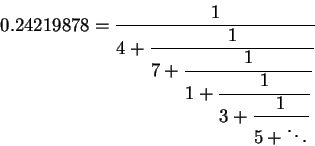

which gives the following sequence of convergents:
The first fraction in the sequence corresponds to the Julian 4 year
cycle system with a single leap year in the cycle. The remaining fractions
offer very inconvenient cycle lengths: 29, 33, 128 and 673 years respectively.
They are, therefore, rejected. (Nevertheless, the idea of a 33-year
period has crossed people's minds. Such a calendar would indeed be
more precise than the current Gregorian calendar, but less precise than
the 500-year cycle calendar disussed below.)
Instead, we would rather have a cycle several centuries long, i.e.![]() ,
where
,
where ![]() must be an integer between 1 and 9. This corresponds to the problem of
approximating the number
must be an integer between 1 and 9. This corresponds to the problem of
approximating the number ![]() by rationals.
by rationals.

We easily compute first 4 convergents:
We see that we have three candidates for the calendar model. The
first one corresponds to our Gregorian calendar. It is based on a 400 year
cycle with 97 leap years: all those divisible by 4 (there is a hundred
of them) except 100th, 200th and 300th years making up the needed 97 leap
years in a cycle. The next fraction 121/5 corresponds to a 500 year cycle
calendar with 121 leap years in each cycle. In such a calendar every year
divisible by 4 would be a leap year unless it is divisible by 100 with
the exception of years divisible by 500, which are still leap years. This
system is as simple and as convenient as the Gregorian calendar and provides
a better accuracy. The Gregorian year is 26 seconds longer than the solar
year resulting in 1 day error each 3,320 years. The 500 year cycle calendar
is 17 seconds shorter than the solar year resulting in 1 day error each
5,031 years. The Pope missed that one. The last choice for the calendar
offers a 900 year cycle. However, with 218 leap years in the cycle the
calendar requires to make 7 exceptions to the fourth year leap rule ![]() .
Making this arrangement would create a more complicated calendar. And besides,
the 900 year cycle may be just a bit too long to be convenient. So, we
would reject this more precise calendar in favor of the simpler ones.
.
Making this arrangement would create a more complicated calendar. And besides,
the 900 year cycle may be just a bit too long to be convenient. So, we
would reject this more precise calendar in favor of the simpler ones.
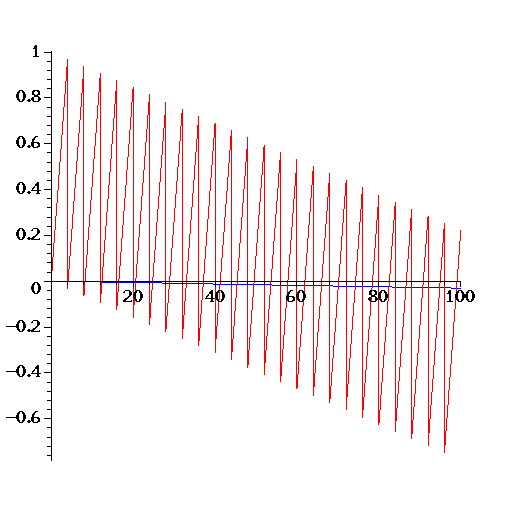
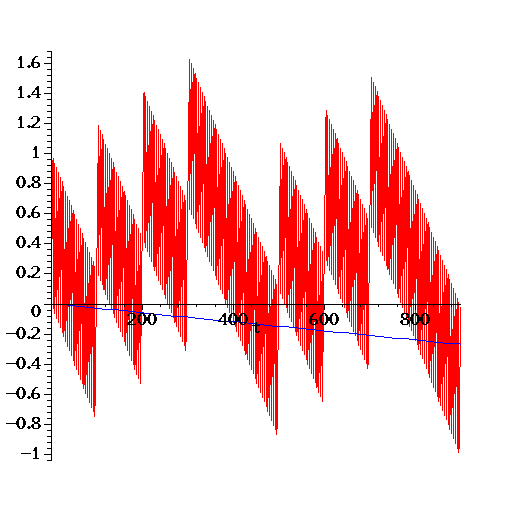
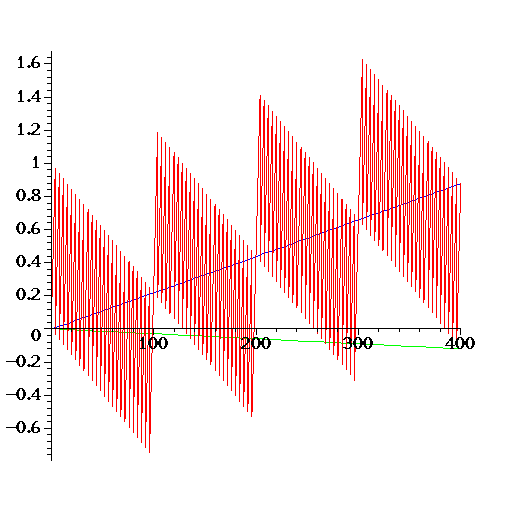
Even Gregorian calendar will accumulate a large error. Eventually.
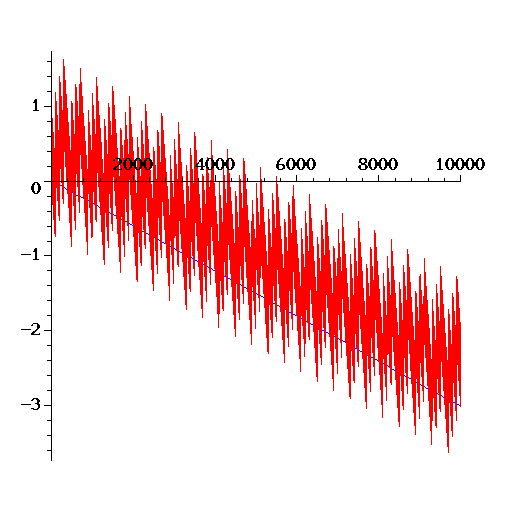
We might speculate what can be done in the future to correct for the
slowly accumulating error of the Gregorian calendar. The idea is to keep
the old system but make some very infrequent corrections. Continued fractions
come handy here again. In other words we are looking for a much longer
cycle length ![]() which would comprise several 400 year cycles:
which would comprise several 400 year cycles: ![]() ,
where
,
where ![]() is the number of 400 year cycles in the new long cycle. We then expand
is the number of 400 year cycles in the new long cycle. We then expand ![]() into a continued fraction.
into a continued fraction.

Convergents are  The third convergent suggests a
The third convergent suggests a ![]() year cycle with
year cycle with ![]() leap years altogether. Recall, that according to the Gregorian calendar,
there is
leap years altogether. Recall, that according to the Gregorian calendar,
there is ![]() leap years in each 400 year cycle. So, within 8 cycles we will have
leap years in each 400 year cycle. So, within 8 cycles we will have ![]() leap years. Thus, canceling the leap year every 3,200 years will allow
us to keep Gregorian calendar in the intervening time, while making it
much more precise. The new system would accumulate a 1 day error in 100,000
years, that is never.
leap years. Thus, canceling the leap year every 3,200 years will allow
us to keep Gregorian calendar in the intervening time, while making it
much more precise. The new system would accumulate a 1 day error in 100,000
years, that is never.
An even more interesting scenario would have been possible had the Pope
done his math. If our calendar was based on a 500 year cycle suggested
above, then we would be expanding ![]() into a continued fraction.
into a continued fraction.
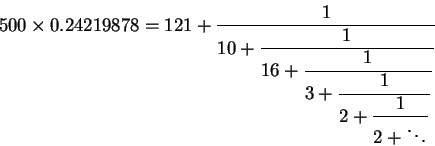
with convergents
The second convergent ![]() suggests a new cycle length of 5,000 years with 1211 leap years in the
cycle. The 500 year cycle calendar would have 1210 leap years. In order
to make 1211 leap years we might want to have February 5,000 have 30 days
in celebration of the 5th millennium. The 5,000 year cycle calendar will
accumulate a 1 day error in a whopping 1 million years. This system has
been suggested by Bernard Rasof ("Continued fractions and 'leap' years",
The Mathematics Teacher, 63, pp. 144-148, 445, 1970.) Be
it as it may, either the Pope didn't do his math (which I find unlikely),
or the astronomical data was not precise enough at the time to justify
the 500 year cycle, or he had other reasons for settling on the current
calendar (for example, the coming-soon 1600 would not increase the discrepancy
between the two versions of the calendar under the 400 year cycle).
suggests a new cycle length of 5,000 years with 1211 leap years in the
cycle. The 500 year cycle calendar would have 1210 leap years. In order
to make 1211 leap years we might want to have February 5,000 have 30 days
in celebration of the 5th millennium. The 5,000 year cycle calendar will
accumulate a 1 day error in a whopping 1 million years. This system has
been suggested by Bernard Rasof ("Continued fractions and 'leap' years",
The Mathematics Teacher, 63, pp. 144-148, 445, 1970.) Be
it as it may, either the Pope didn't do his math (which I find unlikely),
or the astronomical data was not precise enough at the time to justify
the 500 year cycle, or he had other reasons for settling on the current
calendar (for example, the coming-soon 1600 would not increase the discrepancy
between the two versions of the calendar under the 400 year cycle).
The continued fractions can also be used to discover the 19 year Metonic cycle of the Hebrew calendar. In lunar calendars an extra month (from new moon to new moon) is inserted in a leap year. As we mentioned in the beginning, there is 12.368267 lunations a year. Expanding this number into a continued fraction we obtain

with convergents 
The Metonic cycle corresponds to the sixth convergent![]() meaning that there is approximately 235 lunations in 19 years. If all years
contained 12 months then in 19 years we would have
meaning that there is approximately 235 lunations in 19 years. If all years
contained 12 months then in 19 years we would have ![]() .
Therefore, we need to insert 7 more months to make it to 235. The actual
leap year rule requires a calculator: The year
.
Therefore, we need to insert 7 more months to make it to 235. The actual
leap year rule requires a calculator: The year ![]() is a leap year if
is a leap year if ![]() .
.
If you want to learn more about continued fractions the books
Lang, Serge Introduction to Diophantine approximations. Second
edition. Springer-Verlag, New York, 1995.
and
Jones, William B.; Thron, Wolfgang J. Continued fractions. Analytic
theory and applications. With a foreword by Felix E. Browder. With
an introduction by Peter Henrici. Encyclopedia of Mathematics and its Applications,
11. Addison-Wesley Publishing Co., Reading, Mass., 1980.
are excellent references.
The calendar history and continued fractions are also discussed in two
Mathematical Intelligencer articles:
Dutka, Jacques "On the Gregorian revision of the Julian calendar",
Math. Intelligencer 10 (1988), no. 1, 56--64.
and
Rickey, V. Frederick "Mathematics of the Gregorian calendar", Math.
Intelligencer 7 (1985), no. 1, 53--56.
There is another web site that discusses both the calendar and the continued fractions. It focuses, however, more on the calendar part than on continued fractions.
Finally, I would like to mention that I got my idea for doing the public
lecture about it on February 29, 2000 from an article in January/February
2000 issue of one of my favorite magazines Quantum.
The slightly altered version of this web page without the hypertext links can be downloaded as a PDF file.
Yury Grabovsky